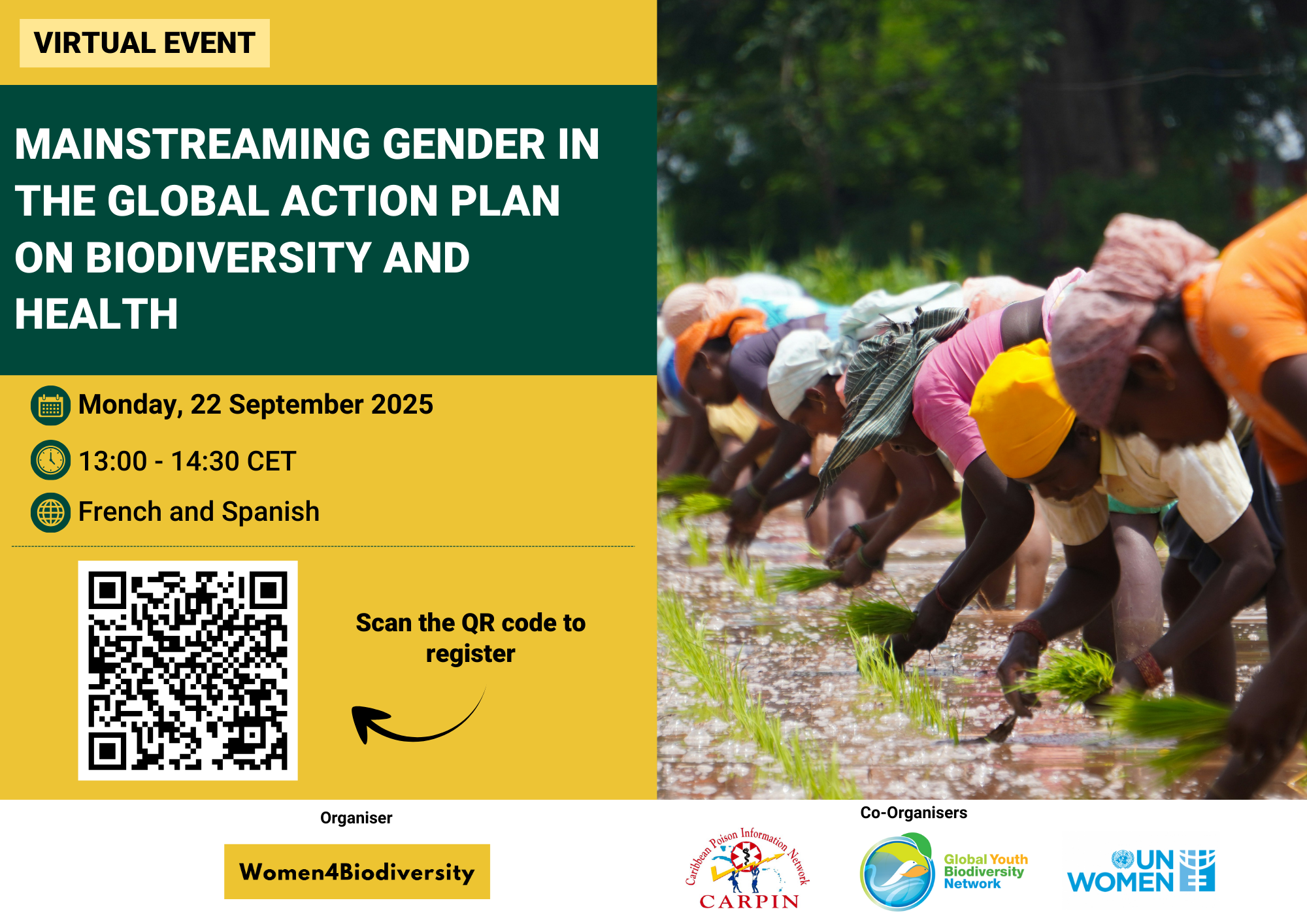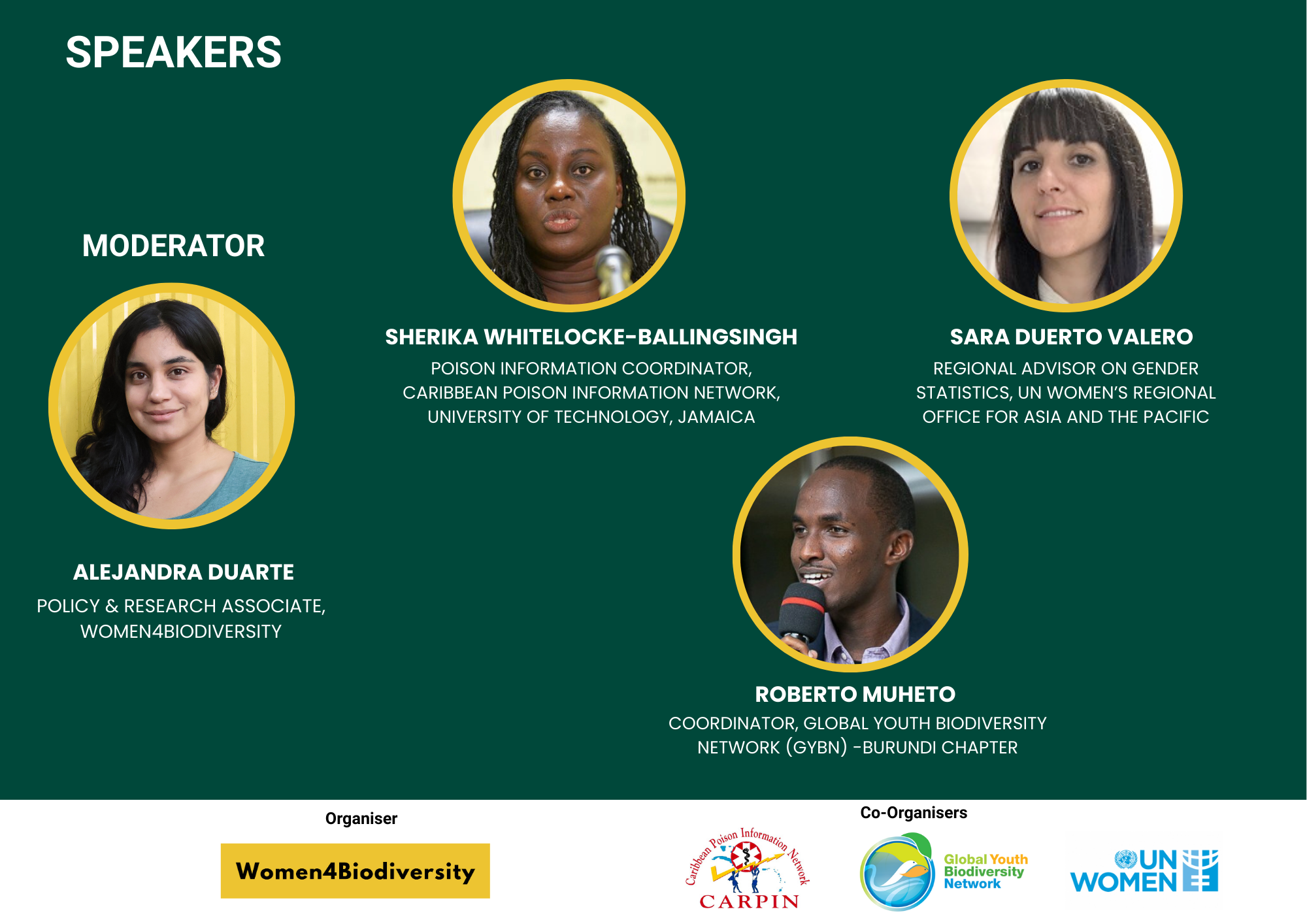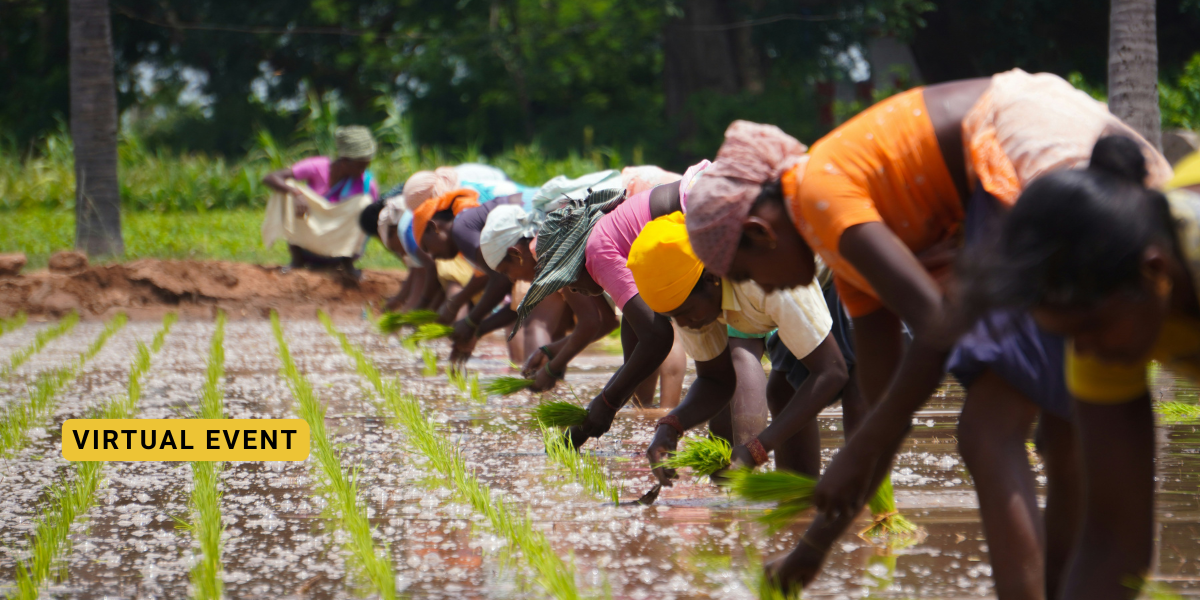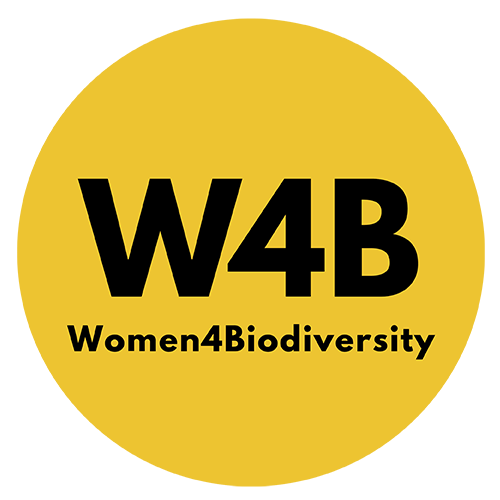Image credit: Deepak Kumar on Unsplash
WHAT
The interconnections between biodiversity and human health are at the forefront of global environmental policy. While major advances have been made with frameworks like the Kunming-Montreal Global Biodiversity Framework (KM-GBF), gender dimensions remain significantly underaddressed. This webinar will explore this critical gap and highlight the importance of integrating gender-responsive metrics and disaggregated data into the implementation of the Global Action Plan on Biodiversity and Health.
This webinar is intended for the Parties to the UN Convention on Biological Diversity (CBD) via their designated Gender-Biodiversity Focal Points and National Focal Points; representatives from the Indigenous Peoples’ and Local Communities; women leaders, organisations, and technical experts who are working on the interlinkages between biodiversity, health, gender, and rights-based approaches.
WHEN
Monday, 22 September 2025, from 1.00 pm to 2.30 pm CET. Please check your timezone here.
WHERE
Online event. Register for the event.
WHO
- Sherika Whitelocke-Ballingsingh, Poison Information Coordinator, Caribbean Poison Information Network, University of Technology, Jamaica
- Sara Duerto Valero, Regional Advisor on Gender Statistics, UN Women’s Regional Office for Asia and the Pacific
- Roberto Muheto, Coordinator, Global Youth Biodiversity Network (GYBN) – Burundi Chapter
- Alejandra Duarte, Research and Policy Associate, Women4Biodiversity – Moderator
WHY
- To highlight the integration of sex and social disaggregated indicators, and gender-responsive metrics and progress measurement tools in the implementation of the Global Action Plan on Biodiversity and Health.
- To amplify the voices and experiences of women, Indigenous Peoples and Local Communities in the biodiversity–health nexus.


Espanol
QUÉ
Las interconexiones entre la biodiversidad y la salud humana ocupan un lugar destacado en la política medioambiental mundial. Si bien se han logrado avances importantes con marcos como el Marco Mundial de Kunming-Montreal para la Diversidad Biológica (KM-GBF), las dimensiones de género siguen sin abordarse suficientemente. En este seminario web se analizará esta laguna crítica y se destacará la importancia de integrar métricas que tengan en cuenta las cuestiones de género y datos desglosados en la aplicación del Plan de Acción Mundial sobre Biodiversidad y Salud.
Este seminario web está dirigido a las Partes del Convenio sobre la Diversidad Biológica de las Naciones Unidas a través de sus puntos focales designados en materia de género y biodiversidad y sus puntos focales nacionales; a los representantes de los pueblos indígenas y las comunidades locales; y a las mujeres líderes, organizaciones y expertas técnicas que trabajan en las interrelaciones entre la biodiversidad, la salud, el género y los enfoques basados en los derechos.
CUÁNDO
Lunes, 22 de Septiembre de 2025, de 13:00 a 14:30 CET. Por favor, compruebe su zona horaria aquí.
DÓNDE
Evento en línea. Inscríbase en el evento.
QUIÉN
- Sherika Whitelocke-Ballingsingh, coordinadora de información sobre intoxicaciones, Red de Información sobre Intoxicaciones del Caribe, Universidad Tecnológica de Jamaica.
- Sara Duerto Valero, asesora regional sobre estadísticas de género, Oficina Regional de ONU Mujeres para Asia y el Pacífico.
- Roberto Muheto, coordinador, Red Mundial de Jóvenes por la Biodiversidad (GYBN), sección de Burundi.
- Alejandra Duarte, investigadora y asociada de políticas, Women4Biodiversity – Moderadora
POR QUÉ
- Para destacar la integración de indicadores desglosados por sexo y condición social, así como métricas sensibles al género y herramientas de medición del progreso en la implementación del Plan de Acción Mundial sobre Biodiversidad y Salud.
- Para amplificar las voces y experiencias de las mujeres, los pueblos indígenas y las comunidades locales en el nexo entre la biodiversidad y la salud.
Francais
QUOI
Les liens entre la biodiversité et la santé humaine sont au cœur des politiques environnementales mondiales. Si des progrès importants ont été réalisés grâce à des cadres tels que le Cadre mondial de Kunming-Montréal pour la biodiversité (KM-GBF), les dimensions liées au genre restent largement négligées. Ce webinaire explorera cette lacune critique et soulignera l’importance d’intégrer des indicateurs sensibles au genre et des données ventilées dans la mise en œuvre du Plan d’action mondial pour la biodiversité et la santé.
Ce webinaire s’adresse aux parties à la Convention des Nations unies sur la diversité biologique (CDB) par l’intermédiaire de leurs points focaux désignés pour le genre et la biodiversité et de leurs points focaux nationaux, aux représentants des peuples autochtones et des communautés locales, aux femmes leaders, aux organisations et aux experts techniques qui travaillent sur les liens entre la biodiversité, la santé, le genre et les approches fondées sur les droits.
QUAND
Lundi 22 septembre 2025, de 13 h à 14 h 30 CET. Veuillez vérifier votre fuseau horaire ici.
Où
Événement en ligne. S’inscrire à l’événement.
QUI
- Sherika Whitelocke-Ballingsingh, coordinatrice des informations sur les poisons, Réseau d’information sur les poisons des Caraïbes, Université de technologie, Jamaïque
- Sara Duerto Valero, conseillère régionale sur les statistiques de genre, Bureau régional de l’ONU Femmes pour l’Asie et le Pacifique
- Roberto Muheto, coordinateur, Réseau mondial des jeunes pour la biodiversité (GYBN) – Section Burundi
- Alejandra Duarte, associée de recherche et de politique, Women4Biodiversity – Modératrice
POURQUOI
- Mettre en avant l’intégration d’indicateurs ventilés par sexe et par catégorie sociale, ainsi que d’outils de mesure des progrès et de métriques sensibles au genre dans la mise en œuvre du Plan d’action mondial pour la biodiversité et la santé.
- Amplifier les voix et les expériences des femmes, des peuples autochtones et des communautés locales dans le domaine de la biodiversité et de la santé.
Event Summary
The relationship between biodiversity and human health is increasingly recognised as a cornerstone of sustainable development and global well-being. As biodiversity declines, so does the resilience of these life-supporting systems, creating complex health challenges. The UN Convention on Biological Diversity (CBD) has acknowledged these interlinkages through the adoption of the Global Action Plan on Biodiversity and Health (CBD/COP/DEC/16/19) at CBD COP16 in Cali, Colombia. Establishing a voluntary framework to strengthen cooperation between the biodiversity and health sectors, aligning with the Kunming–Montreal Global Biodiversity Framework (KM-GBF) targets.
While the Global Action Plan on Biodiversity and Health marks a significant step forward in connecting environmental and health agendas, the gender dimension remains inadequately addressed. Women, Indigenous Peoples and Local Communities bear disproportionate burdens of biodiversity loss and ecological degradation, as their daily livelihoods, care roles, and community responsibilities are deeply intertwined with natural systems. Recognising this persistent gap, Women4Biodiversity organised the webinar “Biodiversity and Health: Mainstreaming Gender in the Global Action Plan on Biodiversity and Health” on 22 September 2025. The discussion aimed to explore practical pathways for strengthening gender-responsive implementation of the Global Action Plan, with emphasis on the inclusion of sex-disaggregated data, social indicators, and participatory approaches that reflect the differentiated experiences and contributions of women, Indigenous Peoples, youth, and other underrepresented groups. The event was hosted by Women4Biodiversity, with participation from the Caribbean Poison Information Network (CARPIN) and UN Women’s Regional Office for Asia and the Pacific.

Dr Sherika Whitelocke-Ballingsingh explained that pollution, soil contamination, and water scarcity create cascading risks for communities reliant on subsistence agriculture and coastal livelihoods. She described how ecosystem degradation disproportionately affects vulnerable groups, particularly women in rural and low-income contexts. Biodiversity loss, she noted, contributes to malnutrition, unsafe food supplies, and increased exposure to emerging diseases. She emphasised that “public health cannot be separated from ecological health,” advocating for regional cooperation to enhance capacity building, policy integration, and project implementation across various sectors. She further highlighted that a gender-responsive approach can enhance resilience and equity in health outcomes.
Sara Duerto Valero presented empirical evidence linking gender and environmental indicators. Drawing from UN Women’s regional data initiatives in Asia and the Pacific, she illustrated how environmental degradation translates into gendered health impacts. Sara cited examples from Cambodia, Liberia, and Samoa, demonstrating how forest loss, air pollution, and soil degradation correlate with increased health burdens for women. In Cambodia, deforestation and habitat loss have been associated with higher malaria prevalence, intensifying women’s unpaid caregiving responsibilities. In Liberia, water pollution affects maternal and child health outcomes, while in Samoa, ecosystem degradation increases women’s workload in managing food insecurity and household nutrition. She emphasised that environmental degradation manifests as both a physical and social health issue for women, impacting nutrition, exposure to toxins, and time poverty.
During the Q&A session, panellists mentioned that the selection of biodiversity and gender indicators should be context-specific and aligned with each country’s ecological, social, and cultural realities. They also encouraged the use of existing global tools, such as those under the UNEP–CBD partnership, as starting points, to be adapted and localised through participatory processes. There is also a need for inclusive consultations and participatory validation mechanisms. “Data must tell the story of the people it represents,” Sherika said, emphasising that active participation is essential to ensuring that biodiversity indicators reflect diverse experiences and are used effectively in decision-making.
The discussion demonstrated that the relationship between biodiversity, health, and gender is multifaceted, spanning data systems, traditional knowledge, and policy implementation. Meaningful gender mainstreaming requires context-sensitive indicators, inclusive data collection, and institutional frameworks that value both science and traditional knowledge. The event concluded with a shared understanding that building equitable biodiversity–health systems depends on participatory governance, strong evidence, and collaboration across sectors and communities.



